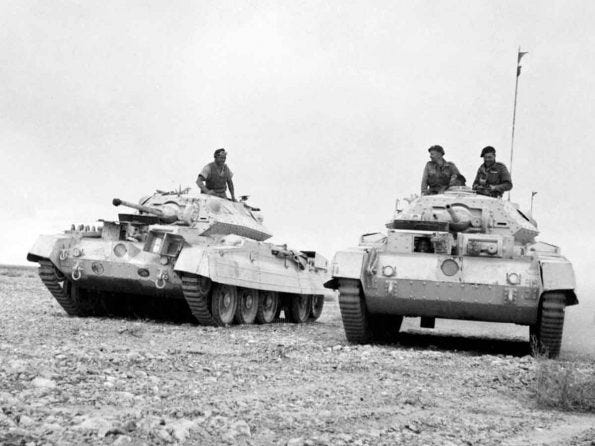Rommel counter-attacks in the desert
17th June 1941: As British 'Operation Battleaxe' fails the Germans advance again

In North Africa the British Operation Battleaxe had been intended to relieve the besieged garrison at Tobruk. Instead it began to reveal the disparity between the British and German equipment. More than once they suffered heavily at the hands of the 88mm gun. The British Matilda tank, although heavily armoured, was too slow. The new Crusader tank was faster but was outgunned by the German tanks.
The German commander Rommel also had the advantage of being able to intercept British communications, which had forewarned him of the attack. Realising on the 16th that the British had been disheartened by their losses he ordered a counter-attack on the 17th:
Next morning, the 17th June, the 5th Light Division set off at the appointed time [4.30am] and after a headlong advance reached the neighbourhood of Sidi Suleiman at 06.00 hours. The 15th Panzer Division had become involved in heavy fighting against an armoured force which the British had sent to parry the danger menacing their army. But it soon reached is objective. Great numbers of destroyed British tanks littered the country through which the two divisions had passed.
This operation had obviously taken the British completely by surprise. In wireless messages which we intercepted they described their position as very serious. The commander of 7th Armoured Division sent a request to the Commander-in-Chief of the desert force to come to his headquarters. It sounded suspiciously as though the British commander no longer felt himself capable of handling the situation.
It being now obvious that in their present bewildered state the British would not start anything for the time being, I decided to pull the net tight by going on to Halfaya. Accordingly, at about 09.00 hours, orders were issued for the 5th Light and 15th Panzer Division to push on to Halfaya and prevent any break-through of British armour from the north.
The British were seriously in trouble over petrol and ammunition and I hoped to be able to force them into a stand-up fight and destroy their whole force.
The enemy wireless was repeatedly reporting lack of ammunition. Soon they set fire to their stores at Capuzzo and withdrew, leaving the desert littered with vehicles abandoned for lack of petrol. They complained bitterly of their high tank casualties.
The 5th Light and 15th Panzer Divisions reached the Halfaya Pass shortly after 16.00 hours. There they turned and advanced side by side to the north. This was a very unfortunate move, as its result was to squeeze out the pocket instead of closing it and preventing the enemy’s escape. Thus the enemy was able to pour back east unmolested through the vast gap between Sidi Omar and Halfaya. I was furious at this missed opportunity. The two divisions should have deployed in front of the enemy as soon as they reached Halfaya, thus bringing him to battle and preventing his escape. In that way we might have raked in a large portion of his offensive power.
See The Rommel Papers.
It is clear that Rommel was getting a tremendous insight into the state of the British forces facing him. Lax British radio security was to continue for many months, giving the Germans an incredible advantage
But it did not give the whole picture and in fact Rommel was mistaken about this missed opportunity - the British had ordered their withdrawal earlier and would have avoided the attempted encirclement anyway.
Rommel was complimentary about the British strategy which was ultimately the responsibility of the Middle East commander, General Sir Archibald Wavell.
Churchill, who had been expecting a great breakthrough with the new tanks, was unimpressed and blamed the British commanders. Wavell would be moved out to India, swapping places with Claude Auchinleck who became the new Commander in Chief Middle East. This was unfortunate as the British were slow to analyse the real reasons for their failure.



